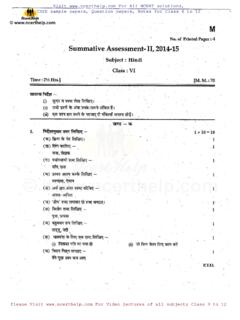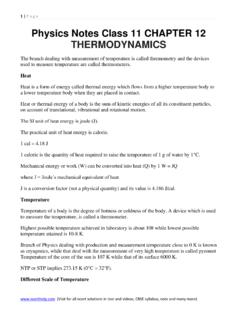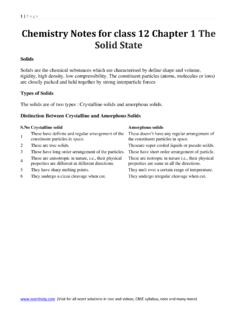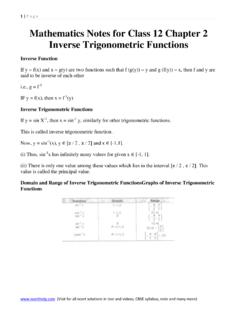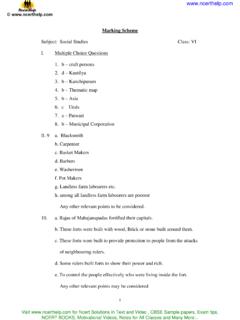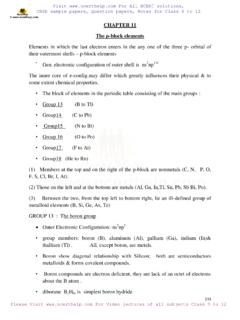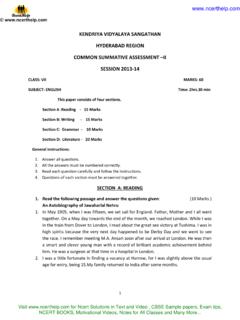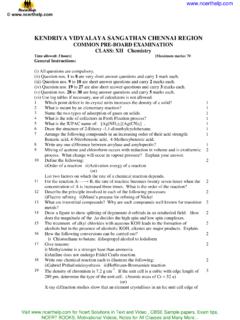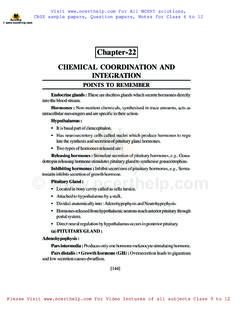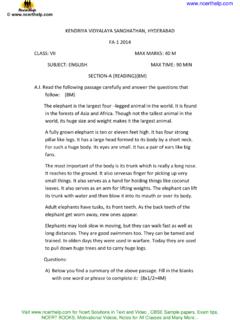Transcription of Mathematics Notes for Class 12 chapter 1. …
1 1 | P a g e (Visit for all ncert solutions in text and videos, CBSE syllabus, note and many more) Mathematics Notes for Class 12 chapter 1. Relations and Functions Relation If A and B are two non-empty sets, then a relation R from A to B is a subset of A x B. If R A x B and (a, b) R, then we say that a is related to b by the relation R, written as aRb. Domain and Range of a Relation Let R be a relation from a set A to set B. Then, set of all first components or coordinates of the ordered pairs belonging to R is called : the domain of R, while the set of all second components or coordinates = of the ordered pairs belonging to R is called the range of R.
2 Thus, domain of R = {a : (a , b) R} and range of R = {b : (a, b) R} Types of Relations (i) Void Relation As A x A, for any set A, so is a relation on A, called the empty or void relation. (ii) Universal Relation Since, A x A A x A, so A x A is a relation on A, called the universal relation. (iii) Identity Relation The relation IA = {(a, a) : a A} is called the identity relation on A. (iv) Reflexive Relation A relation R is said to be reflexive relation, if every element of A is related to itself. Thus, (a, a) R, a A = R is reflexive. (v) Symmetric Relation A relation R is said to be symmetric relation, iff (a, b) R (b, a) R, a, b A , a R b b R a, a, b A R is symmetric.
3 (vi) Anti-Symmetric Relation A relation R is said to be anti-symmetric relation, iff (a, b) R and (b, a) R a = b, a, b A 2 | P a g e (Visit for all ncert solutions in text and videos, CBSE syllabus, note and many more) (vii) Transitive Relation A relation R is said to be transitive relation, iff (a, b) R and (b, c) R (a, c) R, a, b, c A (viii) Equivalence Relation A relation R is said to be an equivalence relation, if it is simultaneously reflexive, symmetric and transitive on A. (ix) Partial Order Relation A relation R is said to be a partial order relation, if it is simultaneously reflexive, symmetric and anti-symmetric on A.
4 (x) Total Order Relation A relation R on a set A is said to be a total order relation on A, if R is a partial order relation on A. Inverse Relation If A and B are two non-empty sets and R be a relation from A to B, such that R = {(a, b) : a A, b B}, then the inverse of R, denoted by R-1 , i a relation from B to A and is defined by R-1 = {(b, a) : (a, b) R} Equivalence Classes of an Equivalence Relation Let R be equivalence relation in A ( ). Let a A. Then, the equivalence Class of a denoted by [a] or {a} is defined as the set of all those points of A which are related to a under the relation R.
5 Composition of Relation Let R and S be two relations from sets A to B and B to C respectively, then we can define relation SoR from A to C such that (a, c) So R b B such that (a, b) R and (b, c) S. This relation SoR is called the composition of R and S. (i) RoS SoR (ii) (SoR)-1 = R-1oS-1 known as reversal rule. Congruence Modulo m Let m be an arbitrary but fixed integer. Two integers a and b are said to be congruence modulo m, if a b is divisible by m and we write a b (mod m). , a b (mod m) a b is divisible by m. 3 | P a g e (Visit for all ncert solutions in text and videos, CBSE syllabus, note and many more) Important Results on Relation If R and S are two equivalence relations on a set A, then R S is also on equivalence relation on A.
6 The union of two equivalence relations on a set is not necessarily an equivalence relation on the set. If R is an equivalence relation on a set A, then R-1 is also an equivalence relation on A. If a set A has n elements, then number of reflexive relations from A to A is 2n2 2 Let A and B be two non-empty finite sets consisting of m and n elements, respectively. Then, A x B consists of mn ordered pairs. So, total number of relations from A to B is 2nm. Binary Operations Closure Property An operation * on a non-empty set S is said to satisfy the closure property, if a S, b S a * b S, a, b S Also, in this case we say that S is closed for *.
7 An operation * on a non-empty set S, satisfying the closure property is known as a binary operation. or Let S be a non-empty set. A function f from S x S to S is called a binary operation on S , f : S x S S is a binary operation on set S. Properties Generally binary operations are represented by the symbols * , +, .. etc., instead of letters figure etc. Addition is a binary operation on each one of the sets N, Z, Q, R and C of natural numbers, integers, rationals, real and complex numbers, respectively. While addition on the set S of all irrationals is not a binary operation.
8 Multiplication is a binary operation on each one of the sets N, Z, Q, R and C of natural numbers, integers, rationals, real and complex numbers, respectively. While multiplication on the set S of all irrationals is not a binary operation. Subtraction is a binary operation on each one of the sets Z, Q, R and C of integers, rationals, real and complex numbers, respectively. While subtraction on the set of natural numbers is not a binary operation. Let S be a non-empty set and P(S) be its power set. Then, the union and intersection on P(S) is a binary operation. 4 | P a g e (Visit for all ncert solutions in text and videos, CBSE syllabus, note and many more) Division is not a binary operation on any of the sets N, Z, Q, R and C.
9 However, it is not a binary operation on the sets of all non-zero rational (real or complex) numbers. Exponential operation (a, b) ab is a binary operation on set N of natural numbers while it is not a binary operation on set Z of integers. Types of Binary Operations (i) Associative Law A binary operation * on a non-empty set S is said to be associative, if (a * b) * c = a * (b * c), a, b, c S. Let R be the set of real numbers, then addition and multiplication on R satisfies the associative law. (ii) Commutative Law A binary operation * on a non-empty set S is said to be commutative, if a * b = b * a, a, b S.
10 Addition and multiplication are commutative binary operations on Z but subtraction not a commutative binary operation, since 2 3 3 2 . Union and intersection are commutative binary operations on the power P(S) of all subsets of set S. But difference of sets is not a commutative binary operation on P(S). (iii) Distributive Law Let * and o be two binary operations on a non-empty sets. We say that * is distributed over o., if a * (b o c)= (a * b) o (a * c), a, b, c S also called (left distribution) and (b o c) * a = (b * a) o (c * a), a, b, c S also called (right distribution).
